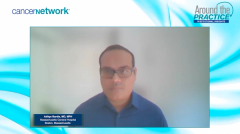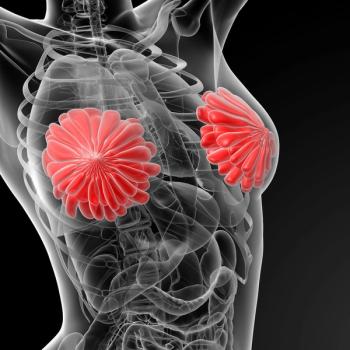
Identifying Use of ctDNA Across Tumor Types
Focusing on breast cancer, lung cancer, and GI cancers respectively, expert oncologists review the utility of circulating tumor DNA assays.
Episodes in this series

Transcript:
John H. Strickler, MD: Dr Bardia, what are the settings in which ctDNA is currently being used in the clinic, and where will we see the most potential applications and growth for this type of technology?
Aditya Bardia, MD, MPH: That is a great question. [Circulating tumor (CT)] DNA has really taken off in the past few years, and if you look at the current application in breast cancer, it’s routinely being used for patients with metastatic breast cancer to identify actionable alterations. A classic example would be the identification of PIK3CA mutation for a patient with hormone receptor-positive metastatic breast cancer, because, if present, the patient would be a candidate for standard therapy with alpelisib, a PIK kinase inhibitor. That’s one example. There are other actionable alterations as well where drugs could either be used off-label or as part of a clinical trial. So that’s where it’s routinely being used in breast cancer. In early breast cancer, it’s still investigational. There are 2 potential applications. The first is during neoadjuvant therapy for patients with HER2-positive breast cancer and triple-negative breast cancer. Neoadjuvant therapy is generally recommended before surgery because it could guide adjuvant therapy based on neoadjuvant response. So that’s where circulating tumor DNA monitoring could be helpful because a couple of studies have shown that if you do not clear ctDNA, you’re much more likely to have residual disease. The third setting would be after surgery, if a patient has residual disease to identify, as Dr Dietrich was mentioning, minimal residual disease. Should we use adjuvant therapy? Should we escalate the use of adjuvant therapy, and vice versa? Should we deescalate the use of adjuvant therapy based on whether there is ctDNA in the adjuvant setting or not? There are ongoing studies looking at this question. It’s not ready for primetime, but certainly, it is an application that we are all excited about.
John H. Strickler, MD: Wonderful. What is the state of the science right now, Dr Bardia, for the ctDNA assays in patients with breast cancer? What type of clinical utility has been established, based on these studies?
Aditya Bardia, MD, MPH: The clinical utility is in metastatic breast cancer for selection of therapy. That’s well established, and it’s routinely used, and it’s something that’s covered by insurance. I always say that we should look at ctDNA, at the time of disease progression on first-line therapy in ER-positive breast cancer because that’s actionable. Some would say even at the diagnosis of metastatic breast cancer, it can be helpful. Then some would advocate for monitoring as well. There are certain alterations such as estrogen receptor mutations or ESR1 mutations that are acquired. So, if you only do ctDNA once, you’re likely going to miss it. But if you do ctDNA serially, then you can capture these acquired alterations, which would be helpful. So, in terms of clinical utility, it is largely in metastatic breast cancer at this time, but there are ongoing studies in early breast cancer, which could establish clinical utility in that setting.
John H. Strickler, MD: Dr Dietrich, you have the perspective of somebody who treats multiple diseases beyond breast cancer. In your perspective, what is the key evidence supporting this type of technology right now in your clinic, where you see a broader number of tumor types?
Martin Dietrich, MD, PhD: I think we have a different set of opportunities here. One is obviously circulating tumor DNA, and it’s descriptive way, I believe, is a pan tumor, independent of site of origin, we can certainly identify the core mutations in breast, colorectal cancer, and lung cancer on liquid-based assays quite well. The much more complex question, and this falls squarely into your area of expertise, is in colorectal cancer in the adjuvant space. I think stage II is probably where we have the most data. In breast cancer and thoracic malignancies, I still think we’re learning about the use of MRD [minimal residual disease]. I think a lot of the trials have been trying to develop assay models that are looking at the prediction of surrogate markers. One of them is the prediction of looking at PCRs [polymerase chain reactions] as a surrogate marker of good outcomes. I think there are 2 strategies that have been applied both on the informed and uninformed platforms. There’s the question about pretreatment DNA, and then the velocity of DNA in circulating nature, the dropping before, during, and after treatment. There were a number of trials, and in every meeting that we go to has a number of them, we’ve seen a great deal of progress in this space. I think what’s very clear is that, as you would expect, the presence of circulating tumor DNA after treatment is a negative prognostic factor, and that the drop and the eradication of circulating tumor DNA does predict the evidence that was supportive of a PCR. I’m not sure if this is ready for prime usage yet, I think those are complementary tests that are helpful in the setting, either of clinical trials or in the absence of other monitoring tools that we have, where this could be utilized. Though I think it’s very clear that this technology is firmly established, that we have a very good way of semiquantitating the presence of circulating tumor DNA, and that they do respond both with disease progression and disease response.
The much bigger question is, is this only descriptive in a prognostic sense? Or do we have a predictive impact here by switching therapies earlier and by escalating or deescalating the therapies as an opportunity to tailor to an individual patient based on their real-time monitoring? I think that question hasn’t been answered in breast or lung cancer at this point, and I’m certainly following this development with great interest.
John H. Strickler, MD: Thank you for that overview. Providing a perspective of a gastrointestinal oncologist like myself, our worldview is shaped by our evidence and what we see, and our current treatment guidelines. We in the GI [gastrointestinal]world have struggled with monitoring and surveillance in the adjuvant setting for patients with colon cancer, specifically stage one through three colon cancer, since 1996 with the initial NCCN [National Comprehensives Cancer Network] guidelines. There have been some core components of that surveillance; obviously exam, imaging colonoscopy, but also a blood-based marker called CEA, which I know you know well. The challenge with CEA is that it’s a highly problematic biomarker for us. It’s part of our national guidelines, and yet, particularly when that CEA is on the low end of an abnormal result, there are more false positives than true positives. That has led to a lot of anxiety on the part of patients, perhaps overutilization of imaging, PET scans, and other tests to chase after a false positive. So that’s provided us, in our GI oncology world, an avenue to potentially bring in some new technology so that we’re smarter about how we do survivorship and surveillance after resection with curative intent; that is specifically stages I, II, and III diseases.
Transcript edited for clarity.
Newsletter
Stay up to date on recent advances in the multidisciplinary approach to cancer.




















































































